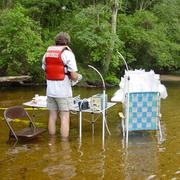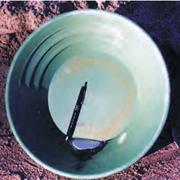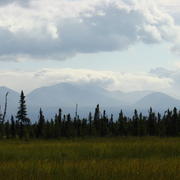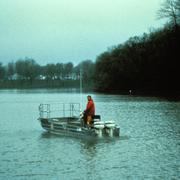Environmental Health
Due to a lapse in appropriations, the majority of USGS websites may not be up to date and may not reflect current conditions. Websites displaying real-time data, such as Earthquake and Water and information needed for public health and safety will be updated with limited support. Additionally, USGS will not be able to respond to inquiries until appropriations are enacted. For more information, please see www.doi.gov/shutdown
Sources of Microbial Contamination at Public Beaches, Santa Barbara
The focus of this study is on analysis of existing hydrologic, chemical, and microbiological data; collection of surface-water and shallow ground-water hydrologic, chemical, and microbiological data; and characterization of dissolved organic carbon composition.
Relation of Groundwater Age to Herbicide Concentration Trends in Fresno and Tulare Counties, California
The California Department of Pesticide Regulation (DPR) has been monitoring pesticide concentrations in about 70 domestic drinking water wells located in vulnerable areas of Fresno and Tulare Counties for approximately 15 years. A recent analysis of the monitoring data indicated that there were decreases in simazine, diuron, and bromacil concentrations in many wells during 2000-2010.
Long-term Studies Examine Contaminant Exposure and Reproduction of Ospreys Nesting in Two Large United States Estuaries
In a series of studies from 2010 to 2018, U.S. Geological Survey (USGS) scientists detected low levels of legacy contaminants and pharmaceuticals in osprey (Pandion haliaetus) and their food chain within the Chesapeake and Delaware River estuaries. Osprey reproductive success increased during the same period and was determined to be adequate to sustain a stable population in both...
Iron Mountain, California: An Extraordinary and Extreme Environment
At its peak production, Iron Mountain ranked as the tenth largest copper production site in the world, sixth in the U.S. and first in California. During its operation, from 1879 - 1963, ten different mines throughout the site's 4,400 acres were the source of not just copper, but also silver, iron, gold, zinc and pyrite (iron sulfide).
The New Jersey Water Quality Networks
The water quality of New Jersey's water bodies is monitored by the USGS New Jersey Water Science Center to characterize waters, identify trends over time, identify emerging problems, determine whether pollution control programs are working, help direct pollution control efforts to where they are most needed, and respond to emergencies such as floods and spills.
Cheyenne River Sioux Tribe
The U.S. Geological Survey collaborates with Native American Tribes such as the Cheyenne River Sioux Tribe in the collection of data and interpretive studies. Previous and current studies and publications for the Cheyenne River Reservation follow. Publications associated with the Cheyenne River Reservation can be found on the "Publications" tab. Selected photographs are included on the "...
Reconstructing millennial-scale hydrologic variability of nearshore environments of south Florida during the Holocene- Lauren Toth
This internship will provide an opportunity to use the USGS’s extensive coral-reef core archive and geochemical laboratory facilities to develop novel paleoclimate and paleoceanographic reconstructions of coral-reef habitats in south Florida. This cutting-edge research will be potentially transformative to our understanding of the millennial-scale evolution of the environments of south Florida...
Mercury
Mercury is a rare, dense metal, slightly more common than gold in the earth's crust. Mercury occurs in several different forms, the most important of which is methylmercury. Methylmercury is the form most readily incorporated into biological tissues and most toxic to humans. Methylmercury accumulates and biomagnifies in the food chain, reaching highest concentrations in predatory fish such as...
Understanding Drivers of Cyanotoxin Production in the Lake Okeechobee Waterway
The U.S. Geological Survey (USGS) and other researchers combined field and laboratory approaches in two studies to understand the factors that drive cyanobacterial bloom development and associated cyanotoxin production in Lake Okeechobee, the St. Lucie River and Estuary, and the Indian River Lagoon in response to the large-scale Lake Okeechobee cyanobacteria bloom in 2016.
Pesticide Occurrence in California – Yolo Bypass Pesticide Analyses
The project is part of an overarching Interagency Ecological Program (IEP)/Department of Water Resources (DWR) study that is focused on understanding the processes by which the Yolo Bypass may provide a fall food web supply for the Cache Slough Complex and downstream regions of the Sacramento/San Joaquin Delta. Several studies conducted since 2011 have shown that phytoplankton blooms can be...
Peatland responses to centennial and millennial-scale changes in North Pacific hydroclimate- Miriam Jones
This study will examine centennial- to millennial-scale North Pacific hydroclimate variability over the late-glacial and Holocene from Alaskan peatlands using cellulose extraction from peatland plants. Hydroclimate analysis will be coupled with vegetation and carbon dynamics to better understand how peatlands respond to long-term climate variability.
Recreational Fishing as driver of overexploitation in inland waters- Doug Beard
Do fisheries managers know the impacts of improving recreational fishing technology on the populations of fish they manage? The role of gear innovations in recreational fisheries is understudied as a driver of overexploitation in inland waters. Examining technology advances will inform recreational managment.













